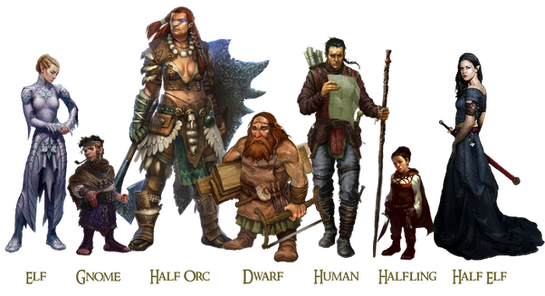Races

To the left are the typical races for an Old School Revival world such as this one. No, there are not any more player character races and even a few of the ones pictured here are not available in this world. The races fit the world of Paksenarrion.
Half-orc - no. There is no backstory that will make it work. The other races pictured here will kill you and any orc on sight. That's this world.
Halflings - no. The elves said they existed when they first came to the northern lands, but disappeared shortly after they arrived. So, no, you cannot play a race that has not been seen by the elves for thousands of years.
Player Races:
Your character's race is detailed from 2 sources: 1. A modified Castle and Crusades race guide (link here). It gives the mechanics (racial bonuses, etc.) and describes the base characteristic traits, 2. Your Prealith culture. It describes the culture and any special characteristics for the race in Prealith. Put another way, #1 tells you what dice to roll and general characteristics while #2 tells you how to role play your character's race in this world. The notes below will give you a very broad idea of the mix.
Castles and Crusades is very similar to Advanced D&D. The comparisons below to D&D are designed to give the player a broad idea of the type of character a certain race can produce....
Gnomes are very different from the standard D&D version. Start with a dwarven template for the mechanics (except no change to attributes). Then, take the gnome pictured here; make him grey skinned and in grey clothes; very serious, extremely lawful (Lawful Neutral), territorial, traditional, very bound to their home and tribe, and with their own magic and a potent military. The usual gnome would be impossible to play. Playing an outcast gnome would be extremely difficult, but possible for a very experienced player. Examine the gnome page for more details and limitations.
Elves are generally true to the D&D version except culturally they are more 'Tolkienish' (i.e. more 'aloof' and arrogant) .... Player characters will need to know whether they are a elf of the Ladysforest or a "Wild Elf". Either elf type gains the advantage "Taig Sense". Arcane magic using elves are illusionists (the Castles and Crusades version).
Examine the elves page for more details and limitations.
Dwarves are the closest to D&D in both mechanics and culture with a few minor differences.
Examine the dwarves page for more details and any limitations.
Humans are close to D&D in mechanics, but the many distinct races/cultures offer a few minor differences in mechanics and very distinct cultures. The human race has the most character class opportunities.
Examine the humans page for the most appropriate culture for their characters.
Half-elves are only slightly different from the D&D version. Half-elves either look much more elvish or much more human at birth and a half-elf who practices a parent's culture will look even more like a member of that culture/race. Examine the half-elf page for more details, favoured classes, etc.
Half-orc - no. There is no backstory that will make it work. The other races pictured here will kill you and any orc on sight. That's this world.
Halflings - no. The elves said they existed when they first came to the northern lands, but disappeared shortly after they arrived. So, no, you cannot play a race that has not been seen by the elves for thousands of years.
Player Races:
Your character's race is detailed from 2 sources: 1. A modified Castle and Crusades race guide (link here). It gives the mechanics (racial bonuses, etc.) and describes the base characteristic traits, 2. Your Prealith culture. It describes the culture and any special characteristics for the race in Prealith. Put another way, #1 tells you what dice to roll and general characteristics while #2 tells you how to role play your character's race in this world. The notes below will give you a very broad idea of the mix.
Castles and Crusades is very similar to Advanced D&D. The comparisons below to D&D are designed to give the player a broad idea of the type of character a certain race can produce....
Gnomes are very different from the standard D&D version. Start with a dwarven template for the mechanics (except no change to attributes). Then, take the gnome pictured here; make him grey skinned and in grey clothes; very serious, extremely lawful (Lawful Neutral), territorial, traditional, very bound to their home and tribe, and with their own magic and a potent military. The usual gnome would be impossible to play. Playing an outcast gnome would be extremely difficult, but possible for a very experienced player. Examine the gnome page for more details and limitations.
Elves are generally true to the D&D version except culturally they are more 'Tolkienish' (i.e. more 'aloof' and arrogant) .... Player characters will need to know whether they are a elf of the Ladysforest or a "Wild Elf". Either elf type gains the advantage "Taig Sense". Arcane magic using elves are illusionists (the Castles and Crusades version).
Examine the elves page for more details and limitations.
Dwarves are the closest to D&D in both mechanics and culture with a few minor differences.
Examine the dwarves page for more details and any limitations.
Humans are close to D&D in mechanics, but the many distinct races/cultures offer a few minor differences in mechanics and very distinct cultures. The human race has the most character class opportunities.
Examine the humans page for the most appropriate culture for their characters.
Half-elves are only slightly different from the D&D version. Half-elves either look much more elvish or much more human at birth and a half-elf who practices a parent's culture will look even more like a member of that culture/race. Examine the half-elf page for more details, favoured classes, etc.